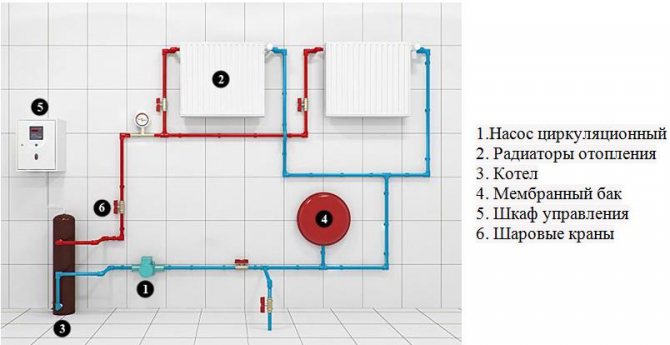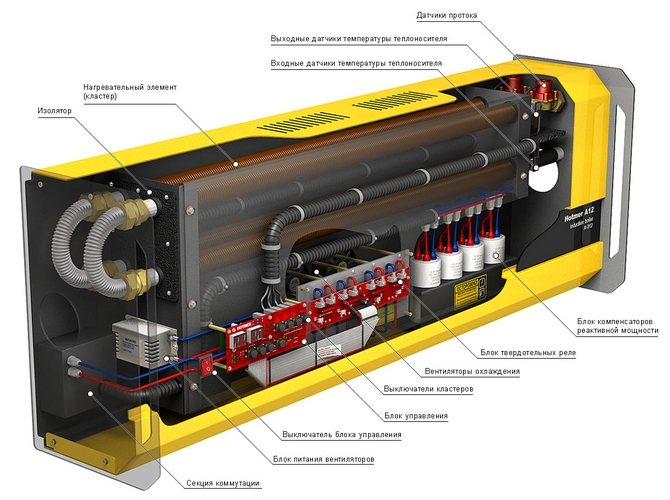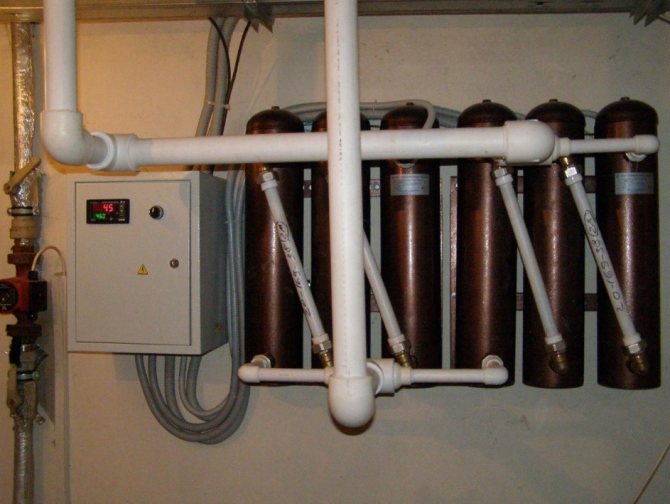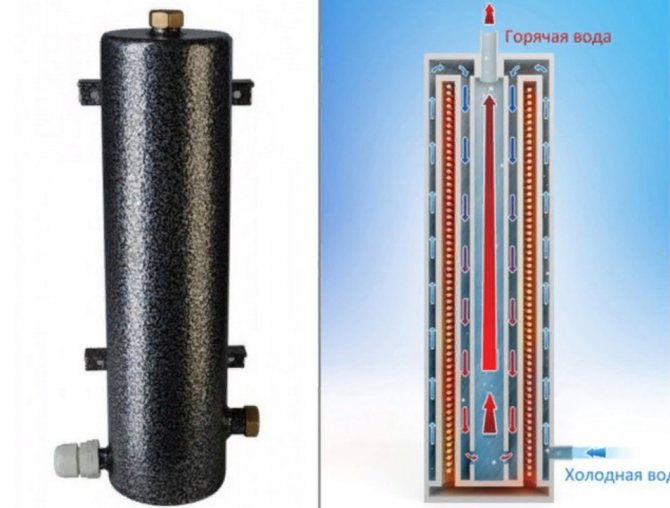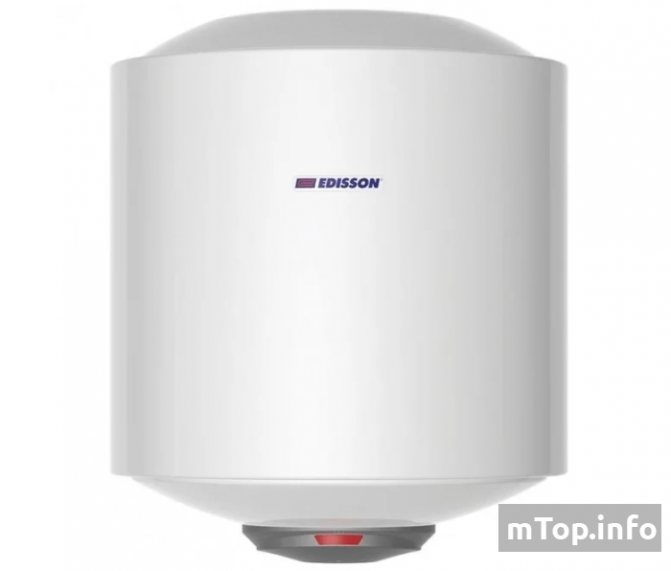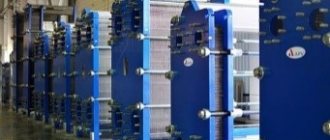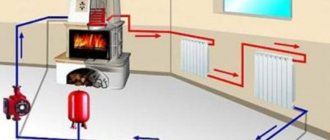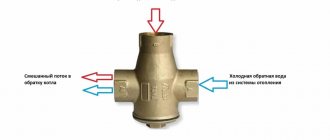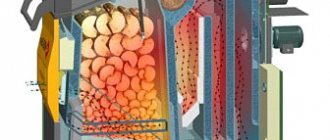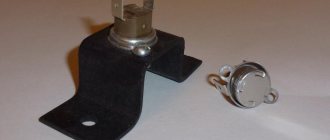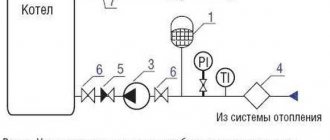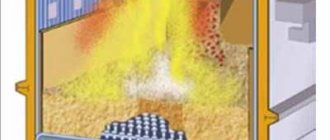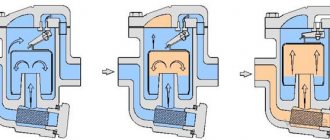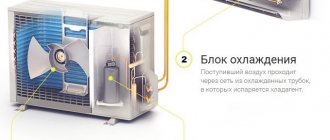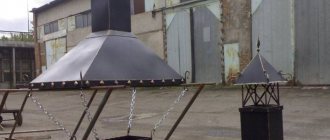The device and principle of operation of the induction heater
Simplified induction heater consists of three components:
- alternator (1);
- inductor (2);
- core (3).
A conductive (metal, graphite) rod is placed in a coil consisting of a certain number of turns of a conductor of a given cross-sectional area without direct contact with it, after which a voltage is applied to the contacts of the coil from the alternator. An electromagnetic field is formed around the turns of the coil, under the influence of which Foucault eddy currents arise in the rod, heating the core. Thus, there is no heat transfer to the core, heat is generated by it independently under the influence of currents floating in it, and can be transferred using a coolant. The temperature of the rod does not rise simultaneously throughout the mass, but from the surface layers to the center, depending on the thermal conductivity of the core material. At the same time, increasing the frequency of the alternating current decreases the depth of inductive heating, but increases its intensity. Particularly noteworthy is the fact that the coil around the core remains practically cold during operation.
This process looks like this:
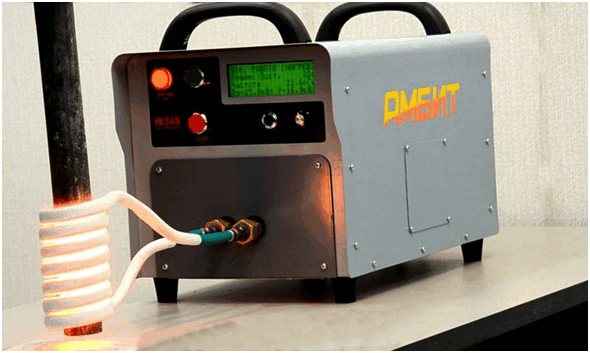
Areas of use
In industry, induction heaters are used for the following complex processes:
- ultrapure metal melting (produced in channel - contactless induction furnaces);
- bending of large diameter steel pipes;

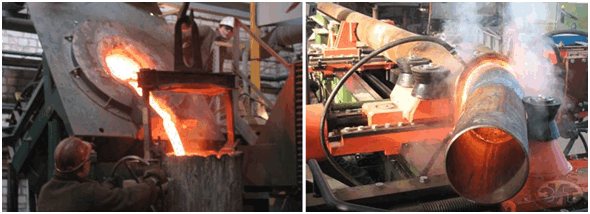
- surface hardening of steel products (construction fittings, parts of transmission mechanisms of machine tools, etc.);
- heat treatment of small parts of complex configuration;


In everyday life, induction heating devices are also widely used. Areas of their application:
- household autonomous heating systems (for summer cottages, apartments, private houses);
- induction hobs and kitchen tiles;
- small-volume crucible furnaces for household metal smelting;
- jewelry craft.
Since the main topic of the article is an induction heater, we will dwell in detail on a heating boiler, which is based on the idea of inductive heating of a coolant.
Induction heater - heating boiler
Since then, as homeowners began to install autonomous heating systems in their homes, the issue of the efficiency of heating boilers for them remains one of the most important. According to this indicator, at least among devices that generate heat from electricity, induction heating boilers are in the lead. At the same time, their power, which is not comparable with the identical parameter of such a device as a baseboard heater, allows the use of units as the main method of heating in large rooms.
Induction heating boilers consist of two circuits - primary (electromagnetic) and secondary (heat exchange piping). The first circuit, consisting of a voltage converter and a heat generator with an induction-type heater, creates an electromagnetic field, eddy currents and generates heat. The second circuit, which includes a heat exchanger with a piping system, transfers this heat through the circulation of the coolant to the radiators of the heating system. Pure water or with additives is used as a heat carrier.
In addition to these two circuits, the heating system includes automation, which is responsible for the operation of individual units of the unit.
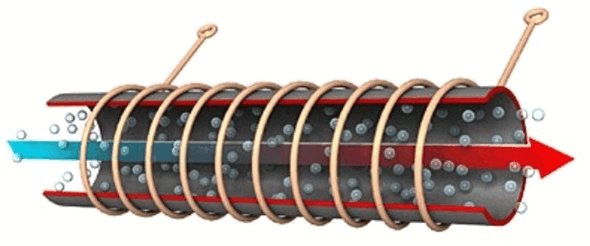

Modern induction heating boilers are installed only in a closed-type heat exchange circuit, which has a membrane-type expansion tank and a forced circulation pump in its design. The use of a circulation pump is a forced measure and is due to the small volume of the coolant at a high intensity of heating of the heat exchanger. The possibility of natural circulation in such a system is excluded - without a pump, water will boil before it starts moving through the pipes.


Important! The induction boiler must always be grounded. In addition, when installing the heating system, the heating medium distribution circuit must be installed from plastic pipes for safety reasons, or the heating unit must be isolated from the steel circuit by inserting polypropylene fittings.
Induction heating boilers are classified in the same way as other electric heating units - in terms of power, design, parameters of consumed electricity. But these devices also have a classification according to the constructive solution of the electrical part.
Varieties of induction boilers
There are the following types of induction-type heating boilers, designated both by the principle of operation and by the manufacturer's brand:
- SAV is a type and at the same time a trademark of new generation boilers with a capacity of 2.5 to 100 kW, manufactured in Russia since 2007;
- VIN - the abbreviation is not only an abbreviation for the name of the type of induction devices (vortex induction heaters), but also the patented name of the boilers produced by Izhevsk.
Induction heaters SAV
Operation of SAV units does not require the use of an inverter; a current of 50 Hz is supplied to the inductor. The electromagnetic field induced by the primary winding causes the formation of vortex flows in the secondary winding, the role of which in boilers of this type is played by a section of a closed circuit of pipes with a coolant. This section of the pipe - the secondary winding is intensely heated under the influence of Foucault currents and transfers heat to the coolant, which is forcedly circulated in the heating system using a circulation pump.
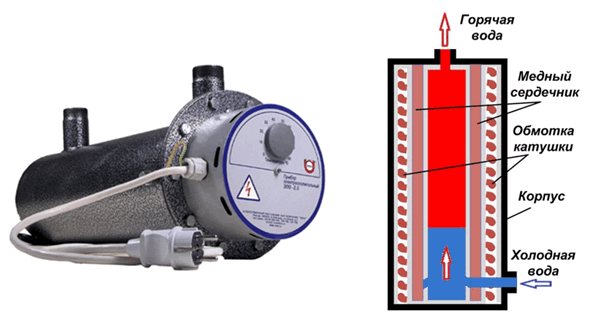

The arrangement of the heating system is carried out using radiators or in a labyrinth way, reminiscent of plinth heating, in order to increase the total area of the outer surface (heat transfer) of the pipes - the heating circuit, at least, should not be minimal in length.


SAV boilers are produced under voltage of 220V and 380V. They use water (in pure form or with anti-freeze additives) as a coolant, as well as antifreeze. It takes about 5-20 minutes for the unit to reach full operating capacity (depending on the volume of the coolant), the efficiency of the heaters of such devices is at least 98%. For efficient heating of premises up to 30 sq. M. an induction device with a capacity of 2.5 kW is enough, the purchase of which, complete with automation and control systems, will cost about 30 thousand rubles.
VIN heating units
Boilers of this type are more advanced in terms of operation and design, which, of course, affects their cost. For the operation of VIN devices, an inverter is required - a device for increasing the frequency of the incoming current. The high frequency current causes the formation of a high intensity electromagnetic field, which, in turn, causes the emergence of more powerful eddy currents in the secondary winding. In addition, the heat exchanger and the boiler body are made of ferromagnetic alloys with their own magnetic field. The result of all these processes is a high intensity of heating the heat exchanger and, of course, the heat carrier.
A VIN-unit with a capacity of 3 kW is enough to heat a room with an area of 35-40 square meters.(depending on climatic conditions and the quality of thermal insulation of external building structures).
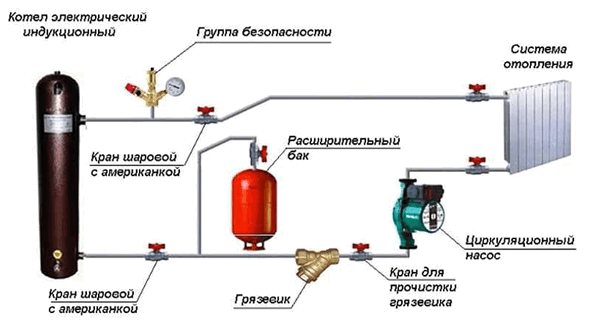

Due to their higher productivity, VIN units can be used not only in heating systems for housing, but also for hot water supply. To do this, additional storage tanks equipped with protective automation are cut into the coolant circuit, the capacity of which is calculated depending on the number of hot water intake points. These containers are provided with hot water by circulating it in a system with direct-flow heating by an induction heater.
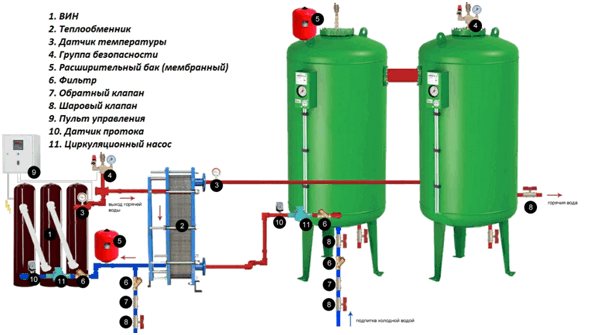

VIN type water heaters
The heart of the unit is a coil consisting of a large number of turns of insulated wire and placed vertically in a cylindrical vessel-like body. A metal rod is inserted inside the coil. The case is hermetically sealed at the top and bottom with welded covers, terminals for connection to the electrical network are brought out. A cold coolant enters the vessel through the lower branch pipe, which fills the entire space inside the body. The water heated to the required temperature goes into the heating system through the upper branch pipe.
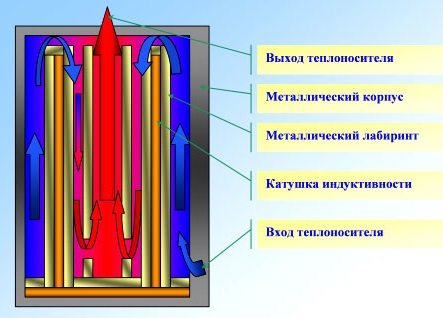

Heating medium heating circuit
By virtue of its design, when connected to the network, the heat generator constantly operates at full capacity, since it is irrational to supply the heating system with additional voltage regulation devices. It is much easier to use cyclic heating and enable automatic shutdown / shutdown with a water temperature sensor. It is only necessary to set the required temperature on the display of the remote electronic unit and it will heat the coolant to this temperature, turning off the hot-water induction element when it is reached. After the time has elapsed and the water has cooled down by a few degrees, the automatics will turn on the heating again, this cycle will be repeated constantly.
Since the winding of the heat generator provides for a single-phase connection with a supply voltage of 220 V, induction-type heating units are not produced with high power. The reason is that the current in the circuit is too high (over 50 amperes), it will require laying cables of large cross-section, which in itself is very expensive. To increase the power, it is enough to enclose three water heating installations in a cascade and apply a three-phase connection with a supply voltage of 380 V. Connect a separate phase to each device in the cascade, the photo shows a similar example of the operation of induction heating.
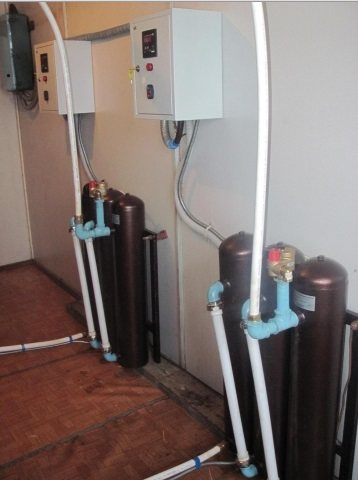

Heating by induction boilers
Design features of heaters of the "Sibtekhnomash" type Using the same effect of electromagnetic induction, another company develops and manufactures water heating devices of a slightly different design, which deserves attention. The fact is that the electric field created by the multi-turn coil has a spatial shape and spreads from it in all directions. If in VIN units the coolant passes inside the coil, then the device of the Sibtekhnomash induction boiler provides for a spiral heat exchanger located outside the winding, as shown in the figure.
The winding creates an alternating electric field around itself, eddy currents heat the turns of the heat exchanger tube, in which water moves. Coil coils are assembled in a cascade of 3 pieces and attached to a common frame. Each of them is connected to a separate phase, the supply voltage is 380 V. The Sibtekhnomash design has several advantages:
- induction heaters have a separate collapsible design;
- in the area of action of the electric field there is an increased area of the heating surface and a greater amount of water due to the spiral circuit, which increases the heating rate;
- heat exchanger lines are available for flushing and maintenance.
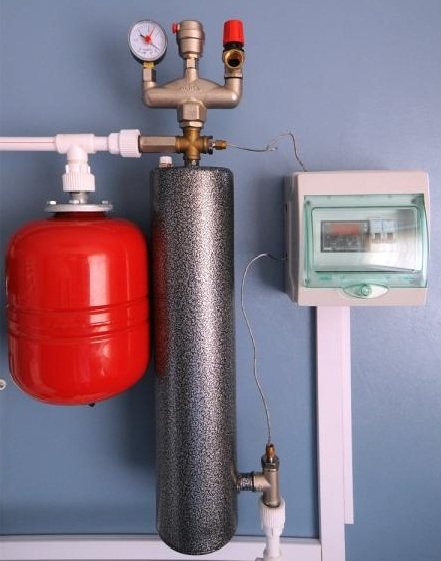

Example of connecting an induction boiler
Despite the differences in the design of the heat generator, the efficiency of its operation is 98%, as in heaters of the "VIN" type, this efficiency value is declared by the manufacturer himself. The durability of the units in either case is determined by the operability of the coils, or rather, by the service life of the winding and electrical insulation, this indicator is set by manufacturers within 30 years.
Evaluating Marketing Claims
Induction heating boilers are credited with many advantages, often without arguments. Let us list these characteristics and give an assessment of the degree to which the statements correspond to the fact:
Profitability
Statement
Electricity consumption by induction boilers is 20-30% less than other electric heaters.
Fact
All heating electrical appliances that do not perform mechanical work convert 100% of the energy of the electric current into heat, their efficiency is always below 100%, but differs in magnitude for different devices in different conditions. To generate 1 kW of thermal energy, it is necessary to spend more than 1 kW of electricity, but how much more depends on the parameters of the dissipation medium. Inside the boiler, of course, losses are also present - for example, for heating the coil, since any conductor material has resistance, but all these losses remain inside the room
Important! Old-style meters (bakelite) will record a lower (1.6 - 1.8 times) electricity consumption than modern electronic ones, since they are not designed to take into account the reactive power of induction boilers.
Perhaps this fact is due to the statement about the efficiency of induction boilers.
Durability
Statement
High reliability and long service life of the equipment - over 25 years.
Fact
Indeed, the absence of moving parts excludes mechanical wear of induction boilers. But the heating system with a VIN unit includes a circulation pump, the resource of which is much more modest. In addition, the control and automation system includes mechanisms that also consist of many components subject to wear.
The core of an induction heater operates under conditions of constant cyclic heating and cooling, temperature deformations, which are also a negative factor. Therefore, to call the resource of induction boilers almost unlimited is an exaggeration. However, it is, in fact, several times higher than heating elements.
Consistency of characteristics over the entire service life
Statement
The absence of scale formation on the inner surface of the pipes ensures the constant efficiency of the heater and heat exchanger.
Fact
Scale is the deposition of salts in water (heat transfer fluid). The amount of these impurities in a limited volume of the coolant is also limited and small, therefore, the effect of scale on the efficiency of the heater is insignificant. And in an induction boiler, the secondary winding is under an almost constant vibration, and no scale formation occurs at all. So the statement is correct, only its significance is exaggerated.
Noiselessness
Statement
The operation of induction heating boilers is silent, which distinguishes them from other electric heaters.
Fact
The statement is true, but - all boilers on electricity do not make noise during operation, since acoustic waves do not enter the range of their oscillations. Only the circulation pump can make noise, but if you wish, you can choose a model of silent action.
Compactness
Statement
Induction boilers are compact, which is convenient when choosing a place for their installation.
Fact
This is indeed the case if you do not use a cascade of induction boilers and do not install intermediate tanks in the presence of several hot water intake points in the hot water supply system, since an induction heater is, by and large, a small piece of pipe with a winding.
Safety
Statement
The safety of the device is absolute.
Fact
There are no absolutely safe electric heaters. When operating induction devices, the possibility of a coolant leakage from the system is not excluded, and the electromagnetic field generator will continue to work, and the system of empty pipes will heat up. To prevent the occurrence of such a situation, an automatic shutdown device is provided in the boiler design, but it can also fail.
Therefore, induction heaters, outperforming competitors in some safety criteria, are not completely safe.
Benefits of geothermal heating
Benefits geothermal system.
Big savings
o Ground source heat pumps have an efficiency 5 times higher than in traditional heating systems and hot water productionusing fossil fuels or electricity.
o Their useful effect is 400% higher, therefore, in order to supply 4 or 5 kW of heat to a house, they only need 1 kW of electricity.
o Therefore, the bowels of the earth are turning into our main source of energy, and this energy is completely free, i.e. the monthly savings are tangibly reflected in our invoices.
o Prices for geothermal heating, maintenance with LLC "House of Your Dream" can be found by contacting us, call today.
Local resource
o You no longer need to worry about the availability and price of fossil fuels. The energy supply for your hearth is guaranteed from anywhere in your own garden.
o Integrated air conditioning system
o Ground source heat pumps provide you with warmth in winter, cooling in summer and hot water all year round. Those. one single unit provides you with a complete air conditioning system.
· Safety.
o The fact that no more gas or a tank for diesel fuel or any other hazardous substance is needed, completely eliminates the potential risk inherent in these products. Such as the risk of intoxication, bad odor, contamination and even explosions due to possible leaks.
Minimal maintenance and long service life
o Although it seems innovative, the technology used in geothermal heat pumps, widely known and completely reliable.
o From the moment of installation and start-up of the installation, your only concern is to enjoy a pleasant temperature in your home all day long.
No flame or smoke
Visual aesthetics are not disturbed
All items heat pump are located underground or inside your home, so the visual aesthetics are not compromised.
· Independence from the outside temperature.
Disadvantages of induction heaters
- The high cost of devices.
- Considerable weight and compactness.
- The presence of a factor of influence of the electromagnetic field on the body and devices.
Let's consider the last point in more detail.
The electromagnetic field affects living organisms in much the same way as food in a microwave oven - heats them to a certain depth, and this can have consequences. The intensity of the impact of the field, including on a person, is determined by such an indicator as the energy flux density (PES), which grows with an increase in the frequency of the current supplied to the primary winding. When operating induction heaters, it is necessary to comply with the sanitary norm of the limit value of the PES, which is established in SanPiN 2.2.4 / 2.1.8.055-96, depends on the duration of the field exposure and is, for example, for an 8-hour exposure - 25 μW / sq.cm, one-hour - 200 μW / sq. cm.
In addition, radiation from the inductor adversely affects nearby electronics and radio equipment, interfering with operation.
Important! To protect yourself from the effects of the electromagnetic field, you can enclose the boiler with a fine-mesh (1x1, 2x2 mm) metal mesh (Faraday cage) that is not in contact with the boiler body and is grounded.
Operating rules
The safe operation of induction heating boilers, like any other technical devices, is ensured by observing a number of rules regarding both their installation and use after installation:
- The boiler must be earthed.
- The distance from the device to the walls on the sides should be at least 30 cm, from the bottom point of the boiler to the floor - 80 cm, from the top point to the ceiling - 80 cm.
- Induction boilers are installed only in a closed circuit with a membrane expansion vessel.
- The system should include a block of safety devices (pressure gauge, air valve, overpressure relief valve, overtemperature shutdown system).
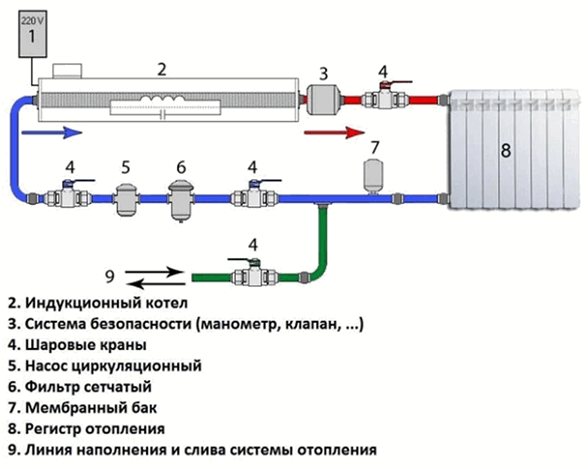

DIY making
Combined boilers for heating with wood and electricity
Making an induction heating boiler with your own hands is not difficult, for this you need to have a sufficient amount of materials and minimal skills in working with electrical equipment. Instructions for the manufacture of such a device include a number of sequential points:
- Selection of material that will be heated. For this, pieces of wire made of steel or wire rod are used. Moreover, the diameter of the rolled product does not exceed 7 millimeters, and the length of the segment is 5 centimeters.
- The boiler body acts as both the base of the inductance coil and the section of the pipeline through which the coolant passes. For the manufacture of the case, plastic pipes are used.
- Installation of the device in the heating circuit is carried out using adapters. Cold heat carrier is supplied through them and the heated medium is discharged.
- The bottom of the plastic pipe is laid out with a metal mesh.
- Further, pieces of wire are poured into the pipe in such an amount that will completely fill the inner part of the body.
- After that, the upper part of the apparatus is clogged.
- The next step is to wind about 90 turns of enamelled copper wire onto the body. This coil is the main part of the heating device.
- After collecting the coil, it is possible to connect the equipment to the heating circuit. To do this, you need to remove a part of the pipe and mount the inductor using adapters.
- After that, you need to connect the coil to the mains using a high-frequency inverter.
This scheme is considered one of the simplest. Its use helps to ensure high-quality heating of the room, and installation does not take much time.
There are also more complex schemes for the manufacture of such induction systems, but their implementation at home requires special skills and more equipment.
Review of renowned manufacturers
- Edison - induction-type heaters with a capacity of 4.7 to 500 kW, produced by Novosibirsk, for domestic and industrial needs;

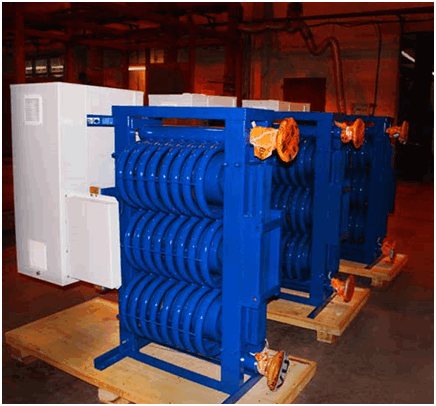
- Miratron - products of the Russian manufacturer of induction heating equipment NPK Miratron for household use, characterized by an advanced design that allows using the equipment without damaging the interior of the room;

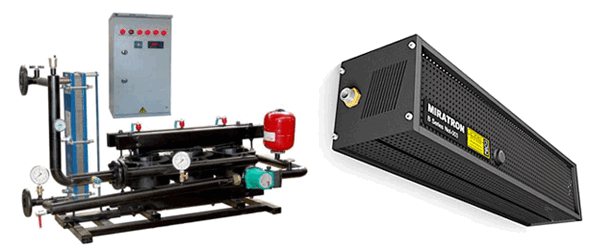
- Teco-House - induction heating boilers with a unique control system, produced by the Ukrainian company of the same name according to EU and Russian Federation standards.
Popular models from the store
The WXJR-B6 induction instantaneous water heater with a maximum power of up to five kilowatts uses the method of heating a liquid from the magnetic field of a coil. The device has a rectangular shape and has dimensions of 270 x 200 x 68 mm; it consumes electricity economically. The outlet produces a constant current of water heated to 60 ° C. It processes from 6 to 11 liters per minute, the operating time is not limited, it is used for large baths and pools with a volume of about 1 thousand liters.
The high-frequency water heater VIN 7 is produced for heating water or working in the heating system of a house with an internal volume of up to 350 cubic meters. The power rating at the limit is 7 kW, the equipment is powered from a 220 V network. The device is round in shape with a height of 615 mm and an outside diameter of 13 mm. Inlet and outlet pipes with a diameter of 20 mm. Effectively heats a large amount of water per minute, the output capacity is 5 thousand 900 kcal per hour.
The Edison 4.7 induction device for heating liquid in the water supply and heating system produces 3 thousand 950 kcal per hour, and consumes 4.7 kW. Connection to household power supply is possible. It is used for buildings with an internal volume of up to 240 cubic meters. The set includes starting equipment, temperature and level sensors, a control cabinet. Manufacturers speak of reliable performance over a 30-year period.

